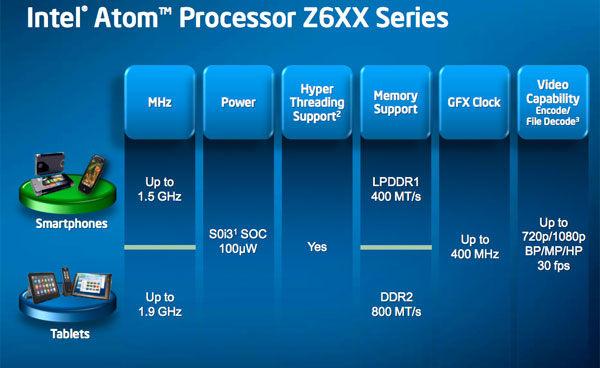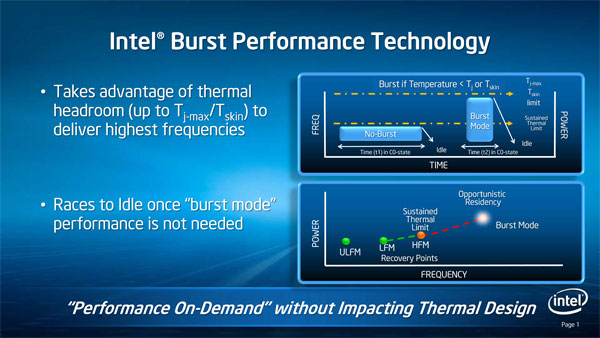Intel Unveils Moorestown and the Atom Z600, The Fastest Smartphone Platform?
by Anand Lal Shimpi on May 4, 2010 11:54 PM EST- Posted in
- Smartphones
- Intel
- Atom
- Mobile
- SoCs
Clock Speeds: 1.2GHz - 1.5GHz for Smartphones, 1.9GHz for Tablets
Intel isn't announcing individual Atom Z600 SKUs just yet, but we do know that all versions of the chip will support Hyper Threading (likely due to maintain a performance advantage compared to upcoming dual-core ARM offerings). There will be two versions of the Atom Z600 chips, one for smartphones and one for tablets.

The smartphone SKUs will run between 1.2GHz and 1.5GHz, while the tablet version of the Z600 will run at up to 1.9GHz.
Power Management: Clock Down or Turbo Up
Eleven years ago Intel demoed a technology it called Geyserville for mobile CPUs. The technology simply ran the CPU at a lower frequency when running on battery power and a higher frequency when plugged in. Intel eventually called this SpeedStep.
Four years later we got EIST, Enhanced Intel SpeedStep Technology. This allowed a mobile (and eventually desktop) CPU to run at any frequency depending on the performance demanded by the OS and the running applications.
On today’s Atom processors this usually means the chip will run as low as 600MHz when idle and at 133MHz increments all the way up to 1.66GHz under load. You don’t normally drop below 600MHz because that falls into the inefficient range of CPU performance scaling for a netbook/nettop. In a smartphone though, the majority of time your CPU isn’t being used. The SoC and accessory processors have enough custom logic offload a lot, even when your phone isn’t idle.
Lincroft, or the Atom Z600 series, supports even lower frequency modes. The CPU can clock itself down well below 600MHz.
When you need performance however Lincroft has something similar to Turbo Boost on Intel’s desktop CPUs. On the Atom Z600 series it’s called Burst Mode and unlike Turbo, it is more tightly integrated with the OS.

EIST and other dynamic clocking technologies rely on OS P-states to determine what frequency the chip should run at. If an OS requests P0, the CPU simply runs at its highest frequency.
On the Core i5 and i7, if the OS requests the CPU be in P0, then as long as the chip doesn’t violate any current or TDP limitations it will run at a higher turbo frequency instead of the default maximum clock speed the OS is requesting. P0 will always return the highest possible frequency given the thermal conditions of the chip.
The Atom Z600 doesn’t work like this. All potential burst mode frequencies are enumerated as P-states by the BIOS. An OS with proper support for Moorestown will be able to request any specific clock frequency, even burst frequencies. Loading a web page for example might result in the OS asking for the highest possible burst mode frequency, but while you’re reading the page the OS might request a slower P-state. The chip will run at whatever the OS requests, but it will exit burst mode if the chip’s temperature gets too high.
The FSB speed also scales with clock frequency. Once you reach a certain clock speed threshold, the Atom Z600 will automatically double its FSB frequency to help feed the CPU faster. The goal isn’t just to deliver peak performance, but it’s also to complete tasks faster so that the SoC can return to an idle state as soon as possible. The hurry up and go idle approach to mobile CPU performance has been one of Intel’s basic tenants for well over a decade now. And it does work. This is the reason we’ve generally seen an increase in battery life from each subsequent version of the Centrino platform.
The software management of burst mode puts more emphasis on the OS and platform vendors to properly tune their devices for the best balance of performance/power consumption. You can see why Wind River’s Android platform and Moblin are necessary to get the most out of Moorestown.










67 Comments
View All Comments
strikeback03 - Thursday, May 6, 2010 - link
Actually, at least on Verizon, there are not many phones that last more than 2-3 days with relatively light use (5-10 min talk, 20-30 txt per day). This is actually something that has gone down in the past few years, as even basic phones get flashier UIs and use more power to run them. And while I support having some phones with weeklong standby time, I am fine with charging my phone or switching batteries every night so long as the phone can last a day in moderate use, which the Snapdragon phones typically can. I like to be able to access more than talk and text on the go.v12v12 - Monday, May 10, 2010 - link
WOW... standing ovation... All of my Droid friends are laughable! Constantly tethered to a power outlet! Always doing something useless and for sure entertainment Vs thinking quietly with their minds... pretty soon "dude I gotta go, my phone is about to die," yeah umm just how many hours have your spent actually TALKING on the dang thing vs playing around with it constantly like some personalized TOY?Battery life should be much more focused upon... The cattle-minded consumers are at it again; now tell me, had to only have 1 car, would you also buy a car that gets the WORST miles per gallon, but has a bunch of silly go-fast features that have you constantly at the fuel pump Vs getting to where you need/should be? Course that's why people usually own 2 cars to separate those needs Vs desires.... Today's "Ferrari" phones have the everyday idiot rambling along, bumping into shit, with their heads constantly fixated on the "screen," like drones. Talking...(?) haha you rarely see people talking with these things, it's just constant "entertainment," even in the most hindering places and social situations. So everyone's got a "Ferrari" phone, but end up trying to use it like a honda; sorry it just doesn't work like that. Faster = more fuel, LESS actual usefulness.
__I'd rather have a phone with a decent amount of enjoyable features, that I can actually take with me on a trip to places that may or may not have power ON-DEMAND lol..
juampavalverde - Wednesday, May 5, 2010 - link
The article and the new product is really interesting, but intel aint ready yet for smartphones, actually this moorestown platform looks much more interesting for pads and handhelds, having more space for such amount of chips, also being x86 with a custom linux. something like an ipad powered by this kind of atom starts to make sense, both from the performance and the battery lifeWorldMage - Thursday, May 6, 2010 - link
The interesting thing about all of the power draw figures given is that they were for workloads wherethe ATOM would be doing almost nothing. Video decode is done by the video decode HW where the
atom might wake up every few seconds to load the next batch of data, similarly for audio playback and
talk time (as you point out cellular modem is the only thing doing work). The thing that gets closest is web browsing, but assuming they are browsing 'static' pages (i.e. no Flash) the atom does a bit of work and probably sits essentially idle for easily 90% of the time.
So it's not surprising they are in the same ballpark as other SOC's for those workloads since they seem to essentially be using the same HW blocks as the competing SOC's. I think it's very telling that all of the power consumption figures from Intel were for essentially non-Atom work loads.
To which you might say "so what?" if those are the work flows that you care about, but that would ignore the fact that the whole point of the atom is to enable "fancy" UI's (and perhaps games) with lots of animation and stuff happening in the background and actually making use of the power of an ATOM.
If you can't actually power the ATOM for an hour of actual use (browsing contacts, checking flights, web pages with Flash ads etc) won't the smart phone be almost worthless?
Th3Loonatic - Thursday, May 6, 2010 - link
On page 3 of the article you misnamed the chips. The one on the left is Lincroft and the one on the right is Langwell.Electrofreak - Friday, May 7, 2010 - link
Anand, Cortex A8 on the 65 nm feature size is reported to use about 0.59 mW per MHz under load, and Cortex A8 on the 45 nm feature size is reported to use 20-30% less than that. For a little bit of added beliveability, Qualcomm's Snapdragon sips in the vicinity of 0.5 mW per MHz on the 65 nm scale, though that may be under optimal circumstances / marketing spin.Ultimately it's roughly half the power consumption Moorestown is reporting. And we notice that nowhere does Intel actually compare their power consumption figures to ARM's.
Additionally, I was under the impression that the A4 had a dual-channel memory controller. I would guess LPDDR2 memory as well, but your guess is as good as mine.
I suspect the S5L8930 in the A4 is a PA Semi (remember Apple bought them) reworked Samsung S5PV210, the dual-channel controller tablet / MID-oriented sister chip to the Samsung Hummingbird S5PC110 (which uses a single-channel controller with LPDDR2 support, if my resources are to be trusted.)
pradeepcvk - Tuesday, November 1, 2011 - link
Anand liked your brief of S0Ix wrt Meego. I wonder how would it work with windows ACPI.could you please have an article for the same.